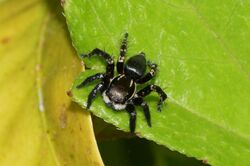Biology:Stenaelurillus specularis
| Stenaelurillus specularis | |
|---|---|

| |
| The related Stenaelurillus albus | |
| Scientific classification | |
| Domain: | Eukaryota |
| Kingdom: | Animalia |
| Phylum: | Arthropoda |
| Subphylum: | Chelicerata |
| Class: | Arachnida |
| Order: | Araneae |
| Infraorder: | Araneomorphae |
| Family: | Salticidae |
| Subfamily: | Salticinae |
| Genus: | Stenaelurillus |
| Species: | S. specularis
|
| Binomial name | |
| Stenaelurillus specularis Wesołowska, 2014
| |
Stenaelurillus specularis is a species of jumping spider in the genus Stenaelurillus that the endemic to Malawi. It was first described in 2014 by Wanda Wesołowska. The spider is small, with a brown cephalothorax between 2.1 and 2.8 mm (0.083 and 0.110 in) in length and a black abdomen between 2.6 and 3.2 mm (0.10 and 0.13 in) long. The carapace has two white streaks and the female abdomen has a triangular-shaped white marking. It is distinguished from other members of the genus by the male's shiny black area on the abdomen, after which the species is named. and the female's short, wide epigyne that has two large oval copulatory openings.
Taxonomy
Stenaelurillus specularis was first described by Wanda Wesołowska in 2014.[1] It is one of over 500 species identified by the Polish arachnologist.[2] It was placed in the genus Stenaelurillus, first raised by Eugène Simon in 1886.[3] The name relates to the genus name Aelurillus, which itself derives from the Greek word for cat, with the addition of a Greek stem meaning narrow.[4] In 2015, Wayne Maddison allocated it in the subtribe Aelurillina in the tribe Aelurillini, which is placed in the clade Saltafresia.[5] Two years later, in 2017, it was grouped with nine other genera of jumping spiders under the name Aelurillines.[6] The species name is a Latin word that can be translated brilliant and recalls the shining area on the male's abdomen.[7]
Description
The spider is small. The male has a cephalothorax that measures between 2.4 and 2.8 mm (0.094 and 0.110 in) in length and between 1.9 and 2.0 mm (0.075 and 0.079 in) in width. The brown carapace is hairy and slightly pear-shaped. It has two white streaks that cross the main part of the body and wide white bands around the margins. The abdomen is oval, black and hairy, between 2.6 and 3.2 mm (0.10 and 0.13 in) long and 1.8 and 1.9 mm (0.071 and 0.075 in) wide, and has a shiny spot that is marked by two patches of non-shiny black. This shiny patch is the most distinguishing feature of the spider. The eye field is black and is surrounded by long brown bristles. The spinnerets are black, and the legs are yellow. The pedipalps are light and hairy and similar to Stenaelurillus darwini but differs in the shape of palpal bulb, having a shorter lobe shape at the rear.[7] The embolus is short. The spider can be distinguished from the similar Stenaelurillus tettu by the narrow and bent projection from the palpal bulb.[8]
The female is similar to the male in size and shape. It has an cephalothorax 2.1 mm (0.083 in) long and 2.1 mm (0.083 in) wide and an abdomen 3.0 in (76 mm) long and 2.2 mm (0.087 in) wide. The carapace is also pear-shaped and coloured similarly, but the abdomen has a large triangular area of white similar to other species in the genus.[7] The spinnerets are light and legs yellow-orange. The epigyne is short, wide and has two large oval copulatory openings.[9] Due to the lack of the abdomen's shiny patch, it is the design of the epigyne that most distinguishes the female of the species from other members of the genus.[7]
Distribution
The species was first identified in the Viphya Mountains of Malawi based on examples found in 1978.[10] It is endemic to the country.[11]
References
Citations
- ↑ World Spider Catalog (2017). "Stenaelurillus specularis Wesolowska, 2014". Natural History Museum. http://www.wsc.nmbe.ch/species/53938/Stenaelurillus_specularis.
- ↑ Wiśniewski 2020, p. 6.
- ↑ Logunov 2020, p. 202.
- ↑ Fernández-Rubio 2013, p. 125.
- ↑ Maddison 2015, p. 279.
- ↑ Prószyński 2017, p. 95.
- ↑ 7.0 7.1 7.2 7.3 Wesołowska 2014, p. 615.
- ↑ Logunov 2020, p. 220.
- ↑ Wesołowska 2014, p. 616.
- ↑ Wesołowska 2014, p. 612.
- ↑ Logunov & Azarkina 2018, p. 14.
Bibliography
- Fernández-Rubio, Fidel (2013). "La etimología de los nombres de las arañas (Araneae)" (in ES). Revista ibérica de Aracnología (22): 125–130. ISSN 1576-9518.
- Logunov, Dmitri V. (2020). "Further notes on the genus Stenaelurillus Simon, 1885 from India (Araneae: Salticidae)". Zootaxa 4899 (1): 201–214. doi:10.11646/zootaxa.4899.1.11. PMID 33756833.
- Logunov, Dmitri V.; Azarkina, Galina N. (2018). "Redefinition and partial revision of the genus Stenaelurillus Simon, 1886 (Arachnida, Araneae, Salticidae)". European Journal of Taxonomy 430: 1–126. doi:10.5852/ejt.2018.430.
- Maddison, Wayne P. (2015). "A phylogenetic classification of jumping spiders (Araneae: Salticidae)". The Journal of Arachnology 43 (3): 231–292. doi:10.1636/arac-43-03-231-292.
- Prószyński, Jerzy (2017). "Pragmatic classification of the World's Salticidae (Araneae)". Ecologica Montenegrina 12: 1–133. doi:10.37828/em.2017.12.1.
- Wesołowska, Wanda (2014). "Further notes on the genus Stenaelurillus Simon, 1885 (Araneae, Salticidae) in Africa with descriptions of eight new species". Zoosystema 36 (3): 595–622. doi:10.5252/z2014n3a3. http://www.bioone.org/doi/full/10.5252/z2014n3a3. Retrieved 7 December 2017.
- Wiśniewski, Konrad (2020). "Over 40 years with jumping spiders: on the 70th birthday of Wanda Wesołowska". Zootaxa 4899 (1): 5–14. doi:10.11646/zootaxa.4899.1.3. PMID 33756825.
Wikidata ☰ Q27505146 entry
 |

